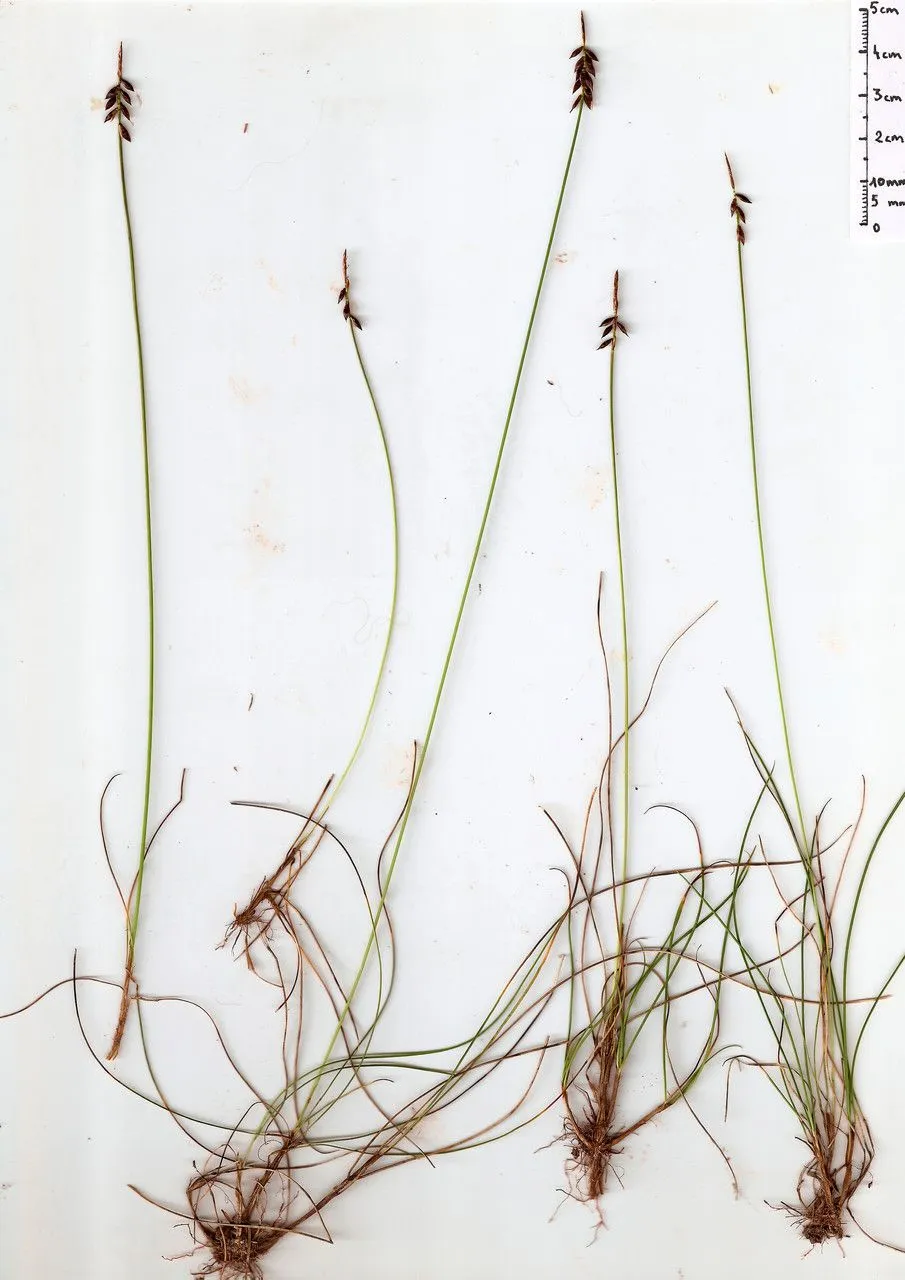
Author: L.
Bibliography: Sp. Pl.: 972 (1753)
Year: 1753
Status: accepted
Rank: species
Genus: Carex
Vegetable: False
Observations: Europe
Flea sedge, known scientifically as Carex pulicaris, is a perennial plant species that belongs to the Cyperaceae family. This distinguished sedge is commonly found across various parts of Europe, where it thrives in moist, acidic soils, often in open, boggy areas and wet meadows.
The characteristics of Carex pulicaris are distinctive, making it relatively easy to identify in the field. Its slender, grass-like leaves are typically arranged in dense tufts. They are accompanied by unique flowering spikes that contribute to its recognition and appreciation among botanists and plant enthusiasts. The plant’s inflorescence is striking with its clustered spikelets, usually featuring a combination of male and female flowers—a common trait within the genus Carex. During its flowering period, which usually spans from late spring to early summer, the spikes develop a light, airy quality, enhancing the plant’s visual appeal in its natural habitat.
The name “Flea sedge” likely arises from the fine, delicate appearance of the flowering spikes, which might be reminiscent of the minuscule size of fleas. Despite the somewhat unflattering common name, Flea sedge plays a crucial ecological role in its native habitats. It forms part of the rich tapestry of species that make up Europe’s diverse wetland ecosystems, contributing to the overall biodiversity.
Carex pulicaris was first formally described by Carl Linnaeus, and this initial description was published in the notable “Species Plantarum” in 1753. Linnaeus, often regarded as the father of modern taxonomy, included this species under the genus Carex, which holds a significant number of species worldwide. His work underscores the importance and long-standing recognition of this plant within the botanical community.
Observations across Europe note this species not only for its ecological significance but also for its aesthetic value in natural landscapes. Flea sedge serves as an indicator of healthy wetland conditions and can be an important species to monitor for conservation efforts aimed at protecting and restoring wetland ecosystems. Its presence often signals good soil health and water conditions, making it a valuable component of environmental assessments.
Overall, Flea sedge (Carex pulicaris) represents more than just its visual appeal; it symbolizes the intricate balance and beauty of wetland habitats. The plant’s contribution to the ecosystem underscores the necessity of conserving these environments, ensuring such species continue to thrive and support the myriad of life forms dependent on wetlands.
Deu: floh-segge
Dan: loppe-star
Eng: flea sedge
Fin: kirppusara
Swe: kirppusara, lopp-star, loppstarr
Fra: laîche puce
Nor: lopp-star
Nob: loppestarr
Nno: loppestorr
Nld: vlozegge
Sme: lahppálukti
Cym: chwein-hesgen, hesg y chwain, hesgen y chwain
En: Flea sedge
Hr: Buhin šaš
Cs: Ostřice blešní
Da: Loppe-star
Nl: Vlozegge
Et: Kirptarn
Fi: Kirppusara
Fr: Laîche puce, Laiche puce, Carex pucier
De: Floh-Segge
It: Carice pulce
Lv: Blusu grīslis
Lt: Blusinė viksva
Se: Lahppálukti
No: Lopp-star
Nb: Loppestarr
Nn: Loppestorr
Pl: Turzyca pchla
Ru: Осока блошиная
Sv: Loppstarr, Kirppusara, Lopp-star
Cy: Hesgen y chwain, Chwein-Hesgen, Hesg y Chwain
Taken Oct 27, 2022 by prasadnayak2002 (cc-by-sa)
Taken Nov 27, 2019 by Rajendra Rajendra Choure (cc-by-sa)
Taken May 1, 2022 by Sandra Jasper (cc-by-sa)
Taken Jun 20, 2019 by Wilhelm Rogmann (cc-by-sa)
Taken May 15, 2007 by Photoflora – Jean-Luc TASSET (©)
Taken May 15, 2007 by Photoflora – Jean-Luc TASSET (©)
Taken Jun 14, 2014 by Tela Botanica − Hugues TINGUY (cc-by-sa)
Taken Jun 20, 2019 by Wilhelm Rogmann (cc-by-sa)
Taken Jun 30, 2016 by Tela Botanica − Florent BECK (cc-by-sa)
Taken Jul 15, 2015 by Photoflora – Benoit BOCK (©)
Taken Jul 15, 2007 by Photoflora – Benoit BOCK (©)
Taken May 15, 2007 by Photoflora – Benoit BOCK (©)
Taken Jul 7, 2005 by Tela Botanica − Jean-Christophe RAGUE (cc-by-sa)
Taken Jul 7, 2005 by Tela Botanica − Jean-Christophe RAGUE (cc-by-sa)
Taken Jul 15, 2003 by Photoflora – Jean-Luc TASSET (©)
Taken Jul 15, 1999 by Photoflora – Jean-Luc TASSET (©)
Taken Jul 15, 1999 by Photoflora – Jean-Luc TASSET (©)
Taken Aug 15, 2009 by Photoflora – Jean-Luc TASSET (©)
Taken Jun 9, 2015 by Tela Botanica − Florent BECK (cc-by-sa)
Taken Aug 15, 2010 by Photoflora – Yann QUELEN (©)
Taken Aug 15, 2009 by Photoflora – Jean-Luc TASSET (©)
Taken Aug 15, 2012 by Photoflora – Benoit BOCK (©)
Taken Jan 1, 1970 by Photoflora – L’Abbé COSTE (©)
Taken Apr 30, 1867 by Tela Botanica − Herbier PONTARLIER-MARICHAL (cc-by-sa)
Growth habit: Graminoid
Ph maximum: 5.5
Ph minimum: 5.0
Light: 8
Atmospheric humidity: 8
Bloom months: [‘may’, ‘jun’]
Soil nutriments: 3
Family: Myrtaceae Author: (F.Muell.) K.D.Hill & L.A.S.Johnson Bibliography: Telopea 6: 402 (1995) Year: 1995 Status:…
Family: Rubiaceae Author: Pierre ex A.Froehner Bibliography: Notizbl. Bot. Gart. Berlin-Dahlem 1: 237 (1897) Year:…
Family: Sapindaceae Author: Koidz. Bibliography: J. Coll. Sci. Imp. Univ. Tokyo 32(1): 38 (1911) Year:…
Family: Asteraceae Author: A.Gray Bibliography: Pacif. Railr. Rep.: 107 (1857) Year: 1857 Status: accepted Rank:…
Family: Fabaceae Author: Medik. Bibliography: Vorles. Churpfälz. Phys.-Ökon. Ges. 2: 398 (1787) Year: 1787 Status:…
Family: Aspleniaceae Author: (Cav.) Alston Bibliography: Bull. Misc. Inform. Kew 1932: 309 (1932) Year: 1932…